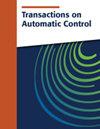带签名网络的多群共识的同态映射设计
IF 7
1区 计算机科学
Q1 AUTOMATION & CONTROL SYSTEMS
引用次数: 0
摘要
本文解决了带有签名网络的多群体共识问题,其中一组具有正权边的代理被视为一个群体,而群体之间的边是负权的。根据群同态理论,将每个群映射为一个虚拟节点,称为群代表节点。因此,有符号网络可以用只有负权边的同态映射图来表示。扩展了结构平衡的定义,消除了结构平衡网络具有偶数个负边的要求。因此,具有负循环的签名网络也被认为是结构平衡的。然后,根据与同态映射图相关的拉普拉斯矩阵的特征,导出了多群对称一致条件。可以得出平均共识和二部共识是多群对称共识的特殊情况。被签名网络中的每一组被分配不同的共识参数,从而实现非对称共识,与对称共识共同形成多组共识控制。本文章由计算机程序翻译,如有差异,请以英文原文为准。
A Homomorphic Mapping Design for Multigroup Consensus With Signed Networks
This article addresses the multigroup consensus problem with signed networks, where a set of agents with positive-weight edges is treated as a group, and the edges among groups are negative weights. Based on group homomorphism theory, each group can be mapped as a virtual node, called the group representative node. Consequently, the signed networks can be represented by the homomorphic mapping graph with only negative weight edges. The definition of structural balance has been extended, eliminating the requirement for a structurally balanced network to have an even number of negative edges. As a result, a signed network with negative cycles is also considered structurally balanced. Then, multigroup symmetry consensus conditions are derived based on the characteristics of the Laplacian matrix associated with the homomorphic mapping graph. It can be concluded that average consensus and bipartite consensus are special cases of multigroup symmetric consensus. Each group in the signed networks is assigned different consensus parameters, thereby achieving asymmetric consensus, which together with symmetric consensus forms multigroup consensus control.
求助全文
通过发布文献求助,成功后即可免费获取论文全文。
去求助
来源期刊

IEEE Transactions on Automatic Control
工程技术-工程:电子与电气
CiteScore
11.30
自引率
5.90%
发文量
824
审稿时长
9 months
期刊介绍:
In the IEEE Transactions on Automatic Control, the IEEE Control Systems Society publishes high-quality papers on the theory, design, and applications of control engineering. Two types of contributions are regularly considered:
1) Papers: Presentation of significant research, development, or application of control concepts.
2) Technical Notes and Correspondence: Brief technical notes, comments on published areas or established control topics, corrections to papers and notes published in the Transactions.
In addition, special papers (tutorials, surveys, and perspectives on the theory and applications of control systems topics) are solicited.
 求助内容:
求助内容: 应助结果提醒方式:
应助结果提醒方式:


